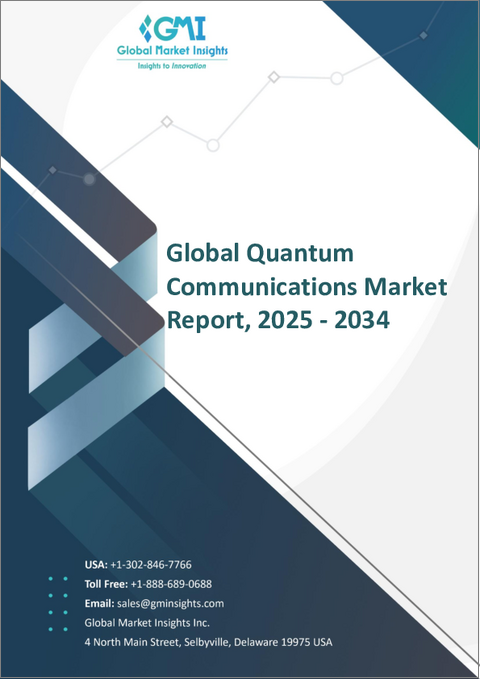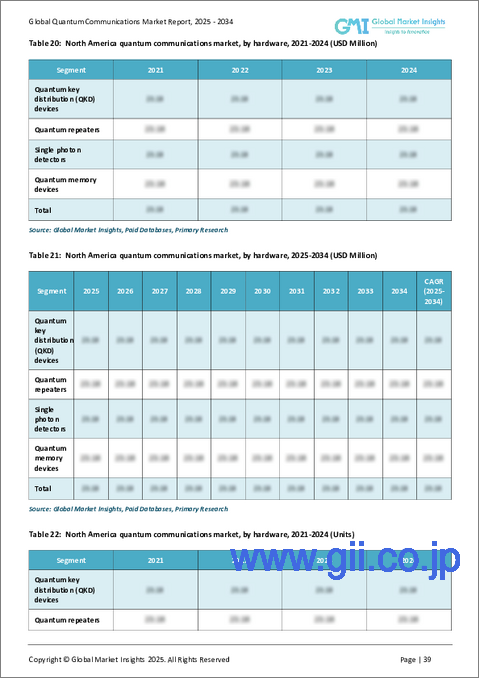|
|
市場調査レポート
商品コード
1797799
量子通信市場の機会、成長促進要因、産業動向分析、2025年~2034年の予測Quantum Communications Market Opportunity, Growth Drivers, Industry Trend Analysis, and Forecast 2025 - 2034 |
||||||
カスタマイズ可能
|
|||||||
| 量子通信市場の機会、成長促進要因、産業動向分析、2025年~2034年の予測 |
|
出版日: 2025年07月18日
発行: Global Market Insights Inc.
ページ情報: 英文 170 Pages
納期: 2~3営業日
|
全表示
- 概要
- 目次
量子通信の世界市場は、2024年には9億5,120万米ドルとなり、CAGR 28.3%で成長し、2034年には105億米ドルに達すると予測されています。
サイバーセキュリティに対する懸念の高まりと、安全性の高いデータ転送システムに対するニーズの高まりが、この市場の急速な拡大に重要な役割を果たしています。世界各国の政府は量子技術の開発に戦略的に投資しており、特に堅牢な量子通信ネットワークの構築に力を入れています。各国は国家的なイニシアチブを開始し、将来即応可能な量子通信システムを構築するための研究インフラを強化するために多額の資金を割り当てています。このような世界の取り組みは、重要なインフラや機密データを保護することを目的としており、官民を問わず先進的な量子ソリューションの導入を視野に入れています。

量子通信技術、特に量子鍵分散(QKD)は、盗聴の試みを検出し、情報の安全な伝送を保証することで、高レベルのデータセキュリティを提供することから、注目を集めています。サイバー脅威の増加や、政府機関や企業に対する機密通信の保護に対する圧力の高まりが、量子ソリューションの幅広い採用を後押ししています。同市場は、安全なデータ通信が優先される防衛、金融、通信などの主要産業からの需要が高いです。これらの分野では、インフラを将来にわたって保護し、ますます厳しくなるデジタル環境においてデータの完全性を維持するために、量子技術が導入されています。衛星ベースの量子ネットワークの採用やファイバーベースのシステムの進化は、市場成長にさらなる勢いをもたらしています。
| 市場範囲 | |
|---|---|
| 開始年 | 2024 |
| 予測年 | 2025-2034 |
| 開始金額 | 9億5,120万米ドル |
| 予測金額 | 105億米ドル |
| CAGR | 28.3% |
2024年の量子通信世界市場において、コンポーネント別ではハードウェアが最大シェアを占め、市場全体の約54%を占める。この分野は予測期間中にCAGR 26%以上で成長すると予測されています。この分野の成長の主な要因は、量子鍵配布の信頼性を確保するために不可欠な光子源、検出器、その他の重要な要素を含む特殊な機器の開発と展開にあります。これらのコンポーネントは、情報サービス、安全な金融取引、政府通信など、最大限の機密性が要求される業務で特に重宝されます。
ネットワークの種類別では、ポイント・ツー・ポイント・ネットワーク・セグメントが2024年の市場シェアで51%を占め、2034年までのCAGRは27%を超えると予測されています。このネットワーク・モデルは、通常半径100キロ以内の近距離通信に最適とされ、オフィス間や都市内の通信ニーズに適しています。この設計は高い忠実度を保証し、データ損失を最小限に抑えるため、各機関は自信を持って安全なデータ交換を行うことができます。光ファイバー技術の進歩は、伝送ロスを減らし、キー生成メカニズムの信頼性を高めることにも役立っています。これらの開発は、量子通信システムの安定性と運用効率を確保する上で極めて重要です。
最終用途別では、政府・防衛分野が量子通信市場で最も急成長している分野の1つとして浮上しています。国家レベルの量子インフラや安全な通信バックボーンへの投資は、サイバー戦争からの防衛や機密情報の保護のために優先的に行われています。各国政府は、国家安全保障を強化するために量子通信への依存を強めており、潜在的なサイバー侵害から重要な業務を確実に保護しています。
地域別では、米国が北米の量子通信市場をリードし、地域別シェアの約82%を占め、2024年の売上高は2億8,420万米ドルに達しました。エネルギー省(DOE)、全米科学財団(NSF)、国防総省(DoD)などの主要機関による連邦政府の取り組みと資金提供の増加が、同国の技術進歩と商業展開を促進しています。このような投資の急増により、米国は量子研究開発の主要拠点として位置づけられ、官民両部門のイノベーションが促進されています。
量子通信業界の主要企業には、東芝、タレス、QuantumCTek、MagiQ Technologies、Arqit Quantum、Qubitekk、Aliro Quantum、ID Quantique、KETS Quantum Security、Quintessence Labsなどがあります。これらの企業は、量子鍵配布、セキュア・ネットワーキング、次世代暗号化技術における最先端ソリューションの開発に貢献しており、安全な世界通信の未来を形作る上で重要な役割を果たしています。
目次
第1章 調査手法
- 市場の範囲と定義
- 調査デザイン
- 調査アプローチ
- データ収集方法
- データマイニングソース
- 世界
- 地域/国
- 基本推定と計算
- 基準年計算
- 市場予測の主な動向
- 1次調査と検証
- 一次情報
- 予測モデル
- 調査の前提と限界
第2章 エグゼクティブサマリー
第3章 業界考察
- エコシステム分析
- サプライヤーの情勢
- 利益率
- コスト構造
- 各段階での付加価値
- バリューチェーンに影響を与える要因
- ディスラプション
- 業界への影響要因
- 促進要因
- データセキュリティに対する懸念の高まり
- 量子ネットワークにおける技術的進歩
- 重要な業界全体での導入拡大
- 政府の取り組みと資金
- 業界の潜在的リスク&課題
- 実装コストが高く、インフラストラクチャが複雑
- 量子中継器なしでは範囲とネットワークの拡張性が制限される
- 市場機会
- 従来の通信インフラストラクチャとの統合
- 量子通信衛星の開発
- 重要な分野のための安全な通信
- 促進要因
- 成長可能性分析
- 規制情勢
- 北米
- 欧州
- アジア太平洋地域
- ラテンアメリカ
- 中東・アフリカ
- ポーター分析
- PESTEL分析
- テクノロジーとイノベーションの情勢
- 現在の技術動向
- 新興技術
- ケーススタディ
- ユースケース
- コスト内訳分析
- 特許分析
- 持続可能性と環境側面
- 持続可能な慣行
- 廃棄物削減戦略
- 生産におけるエネルギー効率
- 環境に優しい取り組み
- カーボンフットプリントの考慮
第4章 競合情勢
- イントロダクション
- 企業の市場シェア分析
- 北米
- 欧州
- アジア太平洋地域
- ラテンアメリカ航空
- 中東・アフリカ
- 主要市場企業の競合分析
- 競合ポジショニングマトリックス
- 戦略的展望マトリックス
- 主な発展
- 合併と買収
- パートナーシップとコラボレーション
- 新製品の発売
- 拡張計画と資金調達
第5章 市場推計・予測:コンポーネント別、2021年~2034年
- 主要動向
- ハードウェア
- 量子鍵配送(QKD)デバイス
- 量子中継器
- 単一光子検出器
- 量子メモリデバイス
- ソフトウェア
- 量子ネットワーク管理
- 暗号鍵管理
- セキュリティプロトコルソフトウェア
- サービス
- コンサルティングと統合
- サポートとメンテナンス
- トレーニングと教育
第6章 市場推計・予測:ネットワーク別、2021年~2034年
- 主要動向
- ポイントツーポイントネットワーク
- ポイントツーマルチポイントネットワーク
- メッシュネットワーク
- 衛星ベースのネットワーク
- ハイブリッドネットワーク
第7章 市場推計・予測:展開モード別、2021年~2034年
- 主要動向
- オンプレミス
- クラウドベース
- ハイブリッド
第8章 市場推計・予測:最終用途別、2021年~2034年
- 主要動向
- 政府と防衛
- 銀行、金融サービス、保険(BFSI)
- ヘルスケアとライフサイエンス
- 通信
- エネルギーと公益事業
- 研究と学術
- 企業および商業
第9章 市場推計・予測:地域別、2021年~2034年
- 主要動向
- 北米
- 米国
- カナダ
- 欧州
- 英国
- ドイツ
- フランス
- イタリア
- スペイン
- ロシア
- 北欧諸国
- アジア太平洋地域
- 中国
- インド
- 日本
- 韓国
- オーストラリア・ニュージーランド
- 東南アジア
- ラテンアメリカ
- ブラジル
- メキシコ
- アルゼンチン
- 中東・アフリカ
- アラブ首長国連邦
- サウジアラビア
- 南アフリカ
- イスラエル
第10章 企業プロファイル
- 既存企業
- Cisco
- Huawei Technologies
- ID Quantique
- Mitsubishi
- NEC
- Nokia
- Toshiba
- 専門企業
- MagiQ Technologies,
- Quantum Communications Hub
- Quantum Xchange
- QuantumCTek Co.
- QuantumCTek Europe
- Qubitekk
- QuintessenceLabs
- SeQure Quantum
- 通信・インフラ企業
- AT&T
- BT Group
- China Telecom
- Deutsche Telekom
- Verizon
- Vodafone
- ハードウェアメーカー
- Aurea Technology
- Excelitas Technologies
- Newport Corp.
- Photon Spot
- Single Quantum
The Global Quantum Communications Market was valued at USD 951.2 million in 2024 and is estimated to grow at a CAGR of 28.3% to reach USD 10.5 billion by 2034. Growing concerns about cybersecurity and the increasing need for highly secure data transfer systems are playing a crucial role in the rapid expansion of this market. Governments across the globe are strategically investing in the development of quantum technologies, with a particular focus on creating robust quantum communication networks. Countries are launching national initiatives and allocating substantial funds to enhance research infrastructure to build future-ready quantum communication systems. These global efforts are aimed at safeguarding critical infrastructure and sensitive data, with a vision of deploying advanced quantum solutions across both public and private sectors.

Quantum communication technologies, especially quantum key distribution (QKD), are gaining traction as they offer high-level data security by detecting eavesdropping attempts and ensuring safe transmission of information. Rising incidents of cyber threats and increased pressure on government agencies and enterprises to protect sensitive communications are encouraging broader adoption of quantum solutions. The market is witnessing high demand from key industries such as defense, finance, and telecom, where secure data transmission is a priority. In these sectors, quantum technologies are being deployed to future-proof infrastructure and maintain data integrity in increasingly hostile digital environments. The adoption of satellite-based quantum networks and the evolution of fiber-based systems are creating additional momentum for market growth.
| Market Scope | |
|---|---|
| Start Year | 2024 |
| Forecast Year | 2025-2034 |
| Start Value | $951.2 Million |
| Forecast Value | $10.5 Billion |
| CAGR | 28.3% |
In terms of components, hardware accounted for the largest share of the global quantum communications market in 2024, representing around 54% of the total market. This segment is anticipated to grow at a CAGR of over 26% during the forecast period. Growth in this area is largely attributed to the development and deployment of specialized equipment, including photon sources, detectors, and other critical elements that are essential to ensure the reliability of quantum key distribution. These components are particularly valuable for operations that demand maximum confidentiality, such as intelligence services, secure financial transactions, and government communications.
Based on network type, the point-to-point networks segment held a dominant 51% market share in 2024 and is projected to grow at a CAGR exceeding 27% through 2034. This network model is considered optimal for short-distance communication, typically within a 100-kilometer radius, making it suitable for inter-office or intra-city communication needs. The design ensures high fidelity and minimizes data loss, allowing institutions to confidently perform secure data exchange. Advances in fiber optic technologies are also helping reduce transmission losses and enhance the reliability of key generation mechanisms. These developments are critical in ensuring the stability and operational efficiency of quantum communication systems.
On the basis of end use, the government and defense segment is emerging as one of the fastest-growing sectors in the quantum communications market. Investments in national-level quantum infrastructure and secure communication backbones are being prioritized to defend against cyber warfare and secure sensitive information. Governments are increasingly relying on quantum communication to bolster national security, ensuring their critical operations remain insulated from potential cyber breaches.
Regionally, the United States led the North American quantum communications market, capturing approximately 82% of the regional share and generating USD 284.2 million in revenue in 2024. Federal initiatives and increased funding from key agencies such as the Department of Energy (DOE), National Science Foundation (NSF), and Department of Defense (DoD) are driving technological advancements and commercial deployment across the country. This surge in investment has positioned the US as a major hub for quantum R&D, fostering innovation across both the public and private sectors.
Leading companies in the quantum communications industry include Toshiba, Thales, QuantumCTek, MagiQ Technologies, Arqit Quantum, Qubitekk, Aliro Quantum, ID Quantique, KETS Quantum Security, and Quintessence Labs. These firms are contributing to the development of cutting-edge solutions in quantum key distribution, secure networking, and next-gen encryption technologies, playing a key role in shaping the future of secure global communications.
Table of Contents
Chapter 1 Methodology
- 1.1 Market scope and definition
- 1.2 Research design
- 1.2.1 Research approach
- 1.2.2 Data collection methods
- 1.3 Data mining sources
- 1.3.1 Global
- 1.3.2 Regional/Country
- 1.4 Base estimates and calculations
- 1.4.1 Base year calculation
- 1.4.2 Key trends for market estimation
- 1.5 Primary research and validation
- 1.5.1 Primary sources
- 1.6 Forecast model
- 1.7 Research assumptions and limitations
Chapter 2 Executive Summary
- 2.1 Industry 3600 synopsis
- 2.2 Key market trends
- 2.2.1 Regional
- 2.2.2 Component
- 2.2.3 Network type
- 2.2.4 Deployment mode
- 2.2.5 End use
- 2.3 TAM Analysis, 2025-2034
- 2.4 CXO perspectives: strategic imperatives
- 2.4.1 Executive decision points
- 2.4.2 Critical success factors
- 2.5 Future outlook and strategic recommendations
Chapter 3 Industry Insights
- 3.1 Industry ecosystem analysis
- 3.1.1 Supplier landscape
- 3.1.2 Profit margin
- 3.1.3 Cost structure
- 3.1.4 Value addition at each stage
- 3.1.5 Factors affecting the value chain
- 3.1.6 Disruptions
- 3.2 Industry impact forces
- 3.2.1 Growth drivers
- 3.2.1.1 Rising concerns over data security
- 3.2.1.2 Technological advancements in quantum networks
- 3.2.1.3 Increasing adoption across critical industries
- 3.2.1.4 Government initiatives and funding
- 3.2.2 Industry pitfalls and challenges
- 3.2.2.1 High implementation costs and infrastructure complexity
- 3.2.2.2 Limited range and network scalability without quantum repeaters
- 3.2.3 Market opportunities
- 3.2.3.1 Integration with classical communication infrastructure
- 3.2.3.2 Development of quantum communication satellites
- 3.2.3.3 Secure communication for critical sectors
- 3.2.1 Growth drivers
- 3.3 Growth potential analysis
- 3.4 Regulatory landscape
- 3.4.1 North America
- 3.4.2 Europe
- 3.4.3 Asia Pacific
- 3.4.4 Latin America
- 3.4.5 Middle East & Africa
- 3.5 Porter's analysis
- 3.6 PESTEL analysis
- 3.7 Technology and innovation landscape
- 3.7.1 Current technological trends
- 3.7.2 Emerging technologies
- 3.8 Case studies
- 3.9 Use cases
- 3.10 Cost breakdown analysis
- 3.11 Patent analysis
- 3.12 Sustainability and environmental aspects
- 3.12.1 Sustainable practices
- 3.12.2 Waste reduction strategies
- 3.12.3 Energy efficiency in production
- 3.12.4 Eco-friendly initiatives
- 3.12.5 Carbon footprint considerations
Chapter 4 Competitive Landscape, 2024
- 4.1 Introduction
- 4.2 Company market share analysis
- 4.2.1 North America
- 4.2.2 Europe
- 4.2.3 Asia Pacific
- 4.2.4 LATAM
- 4.2.5 MEA
- 4.3 Competitive analysis of major market players
- 4.4 Competitive positioning matrix
- 4.5 Strategic outlook matrix
- 4.6 Key developments
- 4.6.1 Mergers & acquisitions
- 4.6.2 Partnerships & collaborations
- 4.6.3 New Product Launches
- 4.6.4 Expansion Plans and funding
Chapter 5 Market Estimates & Forecast, By Component, 2021 - 2034 (USD Million, Units)
- 5.1 Key trends
- 5.2 Hardware
- 5.2.1 Quantum key distribution (QKD) devices
- 5.2.2 Quantum repeaters
- 5.2.3 Single photon detectors
- 5.2.4 Quantum memory devices
- 5.3 Software
- 5.3.1 Quantum network management
- 5.3.2 Cryptographic key management
- 5.3.3 Security protocol software
- 5.4 Services
- 5.4.1 Consulting & integration
- 5.4.2 Support & maintenance
- 5.4.3 Training & education
Chapter 6 Market Estimates & Forecast, By Network, 2021 - 2034 (USD Million)
- 6.1 Key trends
- 6.2 Point-to-point networks
- 6.3 Point-to-multipoint networks
- 6.4 Mesh networks
- 6.5 Satellite-based networks
- 6.6 Hybrid networks
Chapter 7 Market Estimates & Forecast, By Deployment mode, 2021 - 2034 (USD Million)
- 7.1 Key trends
- 7.2 On-premises
- 7.3 Cloud-based
- 7.4 Hybrid
Chapter 8 Market Estimates & Forecast, By End Use, 2021 - 2034 (USD Million, Units)
- 8.1 Key trends
- 8.2 Government and defense
- 8.3 Banking, financial services & insurance (BFSI)
- 8.4 Healthcare and life sciences
- 8.5 Telecommunications
- 8.6 Energy and utilities
- 8.7 Research and academia
- 8.8 Enterprise and commercial
Chapter 9 Market Estimates & Forecast, By Region, 2021 - 2034 (USD Million, Units)
- 9.1 Key trends
- 9.2 North America
- 9.2.1 US
- 9.2.2 Canada
- 9.3 Europe
- 9.3.1 UK
- 9.3.2 Germany
- 9.3.3 France
- 9.3.4 Italy
- 9.3.5 Spain
- 9.3.6 Russia
- 9.3.7 Nordics
- 9.4 Asia Pacific
- 9.4.1 China
- 9.4.2 India
- 9.4.3 Japan
- 9.4.4 South Korea
- 9.4.5 ANZ
- 9.4.6 Southeast Asia
- 9.5 Latin America
- 9.5.1 Brazil
- 9.5.2 Mexico
- 9.5.3 Argentina
- 9.6 MEA
- 9.6.1 UAE
- 9.6.2 Saudi Arabia
- 9.6.3 South Africa
- 9.6.4 Israel
Chapter 10 Company Profiles
- 10.1 Established players
- 10.1.1 Cisco
- 10.1.2 Huawei Technologies
- 10.1.3 ID Quantique
- 10.1.4 Mitsubishi
- 10.1.5 NEC
- 10.1.6 Nokia
- 10.1.7 Toshiba
- 10.2 Pure-play companies
- 10.2.1 MagiQ Technologies,
- 10.2.2 Quantum Communications Hub
- 10.2.3 Quantum Xchange
- 10.2.4 QuantumCTek Co.
- 10.2.5 QuantumCTek Europe
- 10.2.6 Qubitekk
- 10.2.7 QuintessenceLabs
- 10.2.8 SeQure Quantum
- 10.3 Telecom and infrastructure companies
- 10.3.1 AT&T
- 10.3.2 BT Group
- 10.3.3 China Telecom
- 10.3.4 Deutsche Telekom
- 10.3.5 Verizon
- 10.3.6 Vodafone
- 10.4 Hardware manufacturer
- 10.4.1 Aurea Technology
- 10.4.2 Excelitas Technologies
- 10.4.3 Newport Corp.
- 10.4.4 Photon Spot
- 10.4.5 Single Quantum






